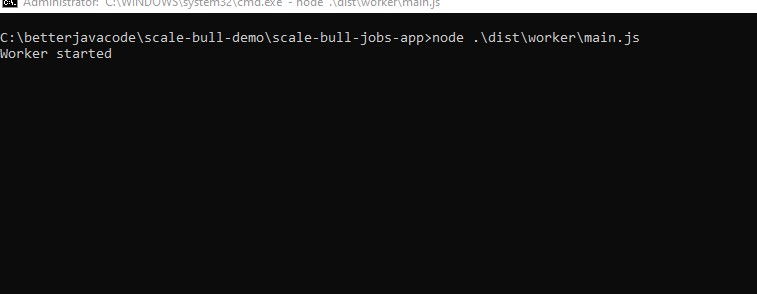In this post, I want to show how to scale processing of bull jobs in a NestJS Application. As we know, we can use Bull Queue mechanism for asynchronous tasks, we can also easily process a lot of tasks parallelly using Bull Queue. One technique is to use horizontal scaling your workers.
This post will show the demonstration of horizontal scaling of bull queue workers.
Contents
Introduction
This is a simple idea and I want to show case the scaling power of bull queue. One thing I really like about bull jobs is that they are performant and easy to scale. The jobs also give an option to do asynchronous processing. Keep in mind that if you have a CPU intensive task, you can still use Bull queue. I have covered how to use Bull Queue for asynchronous processing.
As part of this post, we will upload a large file. The controller stores the file on disk, but adds a job to bull queue. The worker for this job will then read the file data and add each record to another bull queue.
We will have multiple workers to process file data. Each worker will process a separate job that is there in the bull queue.
Adding a single job
Let’s start with a single job first. I will not be covering any fundamentals about Bull Queues and workers. I previously wrote about worker pattern.
Nevertheless, we have a NestJS application with an API to upload a file. This API will create the first job in the queue file-upload-queue as follows:
@Post('/uploadFile')
@UseInterceptors(FileInterceptor("csv", {
storage: diskStorage({
destination: './csv',
fileName: (req, file, cb) => {
const randomName = Array(32).fill(null).map(() => (Math.round(Math.random() * cb(null, `${randomName}${extname(file.originalname)}`))))
}
})
}))
async uploadLargeCsvFile(@UploadedFile() file): Promise {
const job = await this.fileQueue.add('process-file', {file: file});
console.log(`created job ${ job.id}`);
await this.fileQueue.close();
}
Above code basically adds a job to file-upload-queue to process that file.
Adding multiple jobs
One of the features that bull library offers to add multiple jobs to a queue. In our example, we read the data from file and we add each record as a job to another bull queue. This allows us to add multiple jobs to queue file-data-queue.
import { InjectQueue, Process, Processor } from "@nestjs/bull";
import { Job, Queue } from "bull";
const csv = require('csvtojson');
@Processor('file-upload-queue')
export class FileUploadProcessor{
constructor(@InjectQueue('file-data-queue') private fileDataQueue: Queue) {}
@Process('process-file')
async processFile(job: Job) {
const file = job.data.file;
const filePath = file.path;
const userData = await csv().fromFile(filePath);
await this.fileDataQueue.addBulk(userData.map(user => ({
name: 'process-data',
data: user
})));
console.log('file uploaded successfully');
}
}
We use addBulk functionality to add all the records from the file to queue file-data-queue.
Worker
Creating a worker through NestJS framework is simple. NestJS has a feature to run standalone application. We will use the same to run our workers while creating a separate module to process jobs from file-data-queue.
Our separate module FileDataModule will have a processor to process each record from the file.
import { Process, Processor } from "@nestjs/bull";
import { Job } from "bull";
@Processor('file-data-queue')
export class FileDataProcessor{
@Process('process-data')
async processFile(job: Job) {
const data = job.data;
console.log('processing data for a single user');
console.log(data);
// To-Do add some processing like inserting this data in DB
}
}
We will use createApplicationContext to create a worker for FileDataModule like below:
import { NestFactory } from "@nestjs/core";
import { FileDataModule } from "src/file-read/file-data.module";
async function main() {
const app = await NestFactory.createApplicationContext(FileDataModule,
{
bufferLogs: true,
abortOnError: false,
}
);
app.enableShutdownHooks();
await app.init();
console.log(`Worker started`);
process.on('SIGINT', async () => {
console.log(`SIGINT signal received`);
try {
console.log('closing app...');
await app.close();
console.log(`Worker stopped`);
} catch (error) {
console.error(`Error during shutdown: ${error.message}`);
} finally {
console.log('exiting...');
process.exit(0);
}
});
}
main();
This worker basically starts the application and waits for SIGINT signal to be terminated. Considering this worker is create the application context for FileDataModule, it uses the processor FileDataProcessor to process data from the queue.
Scaling Workers
We will run two instances of the worker we created above. We will also be running our NestJS Application and if we have imported FileDataModule in our main application module, we will have three instances of FileDataProcessor running to process the jobs from the bull queue file-data-queue.
There are two concepts to understand in Bull Queue since bull can offer either.
Parallelism
In Parallelism, two or more tasks run in parallel, independent of each other. The simplest way to understand this is when you have multiple machines running and each performing its own task.
Concurrency
Two or more tasks runs at the same time while diving the available CPU so that all the tasks can advance in their processing.
Concurrency might not increase the throughout, but parallelism will. Parallelism also scales linearly that means if you add more workers, more jobs will get processed.
Bull offers configuration for concurrency. But in this demo, we are focusing on parallelism.
Demo
We have already described the scenario. We have a NestJS application with an API to upload a file is running in one terminal. We have two workers running in two other terminals.
We upload the file through Postman with our API. This API will create the first job. Processor for this job then adds multiple jobs to another queue file-data-queue.
The NestJS application and the two workers then process jobs from this queue in parallel. The three screenshots below show the application, the worker 1 and the worker 2.

Conclusion
In this post, I showed how to scale bull job workers horizontally. This allows us to process jobs with high throughput. The code for this post is available here.